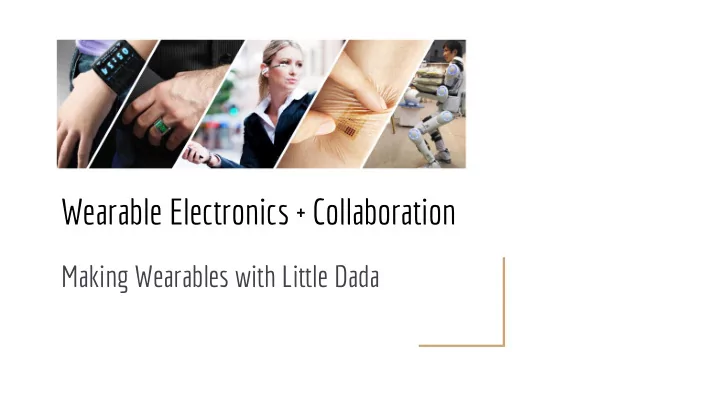

Wearable Electronics + Collaboration Making Wearables with Little Dada
Hi! We’re Little Dada + Make Art + Hold Community Events + www.littledada.ca Lindy Wilkins (left) Hillary Predko (right)
Little Dada: conferences, meet ups, hackathons, art installations
What is a wearable? Clothing and accessories incorporating computer and advanced electronic technologies.
We all have bodies!
Steve Mann - Evolution of Wearable Camera
Wearability is defined as the interaction between the human body and the wearable object. Dynamic wearability extends that definition to include the human body in motion. However, simply shrinking down computing tools from the desktop paradigm to a more portable scale only makes them into mini PC’s. It does not take advantage of the opportunities presented by a whole new context of use. It does not regard the human body as a context. -Design for Wearability by Francine Gemprele
Placement Design for dynamic wearability requires unobtrusive placement. Placement is determined by editing the extensive human surface area with the use of criteria.
Form Language Design for the human body also requires a humanistic form language. This works with the dynamic human form to ensure a comfortable, stable fit.
Human Movement Human movement provides both a constraint and a resource in the design of dynamic wearable forms. Human movement is useful in determining a profile or footprint for wearable forms, as well as to shape the surface of forms. Consider the many elements that make up any single movement. Elements include the mechanics of joints, the shifting of flesh, and the flexing and extending of muscle and tendons beneath the skin.
Proxemics Design for human perception of size. The brain perceives an aura around the body that should be considered to determine the distance a wearable form projects from the body. Forms should stay within the wearers intimate space, so that perceptually they become a part of the body.
Sizing Size variation provides an interesting challenge when designing wearable forms. Both the build of a body and the ways in which it will gain and lose weight and muscle are important. Wearables must be designed to fit as many types of users as possible. Listen to On Average from 99 Percent Invisible
Comfort Comfortable attachment of forms can be created by wrapping the form around the body, rather than using single point fastening systems such as clips or shoulder straps.
Finding Affordances ● Pockets ● Seams ● Linings
Some Beautiful Circuits Wei Chieh Shih (and another video)
Anu Koski
Becky Stern
kanai.tetsuo
Push_rest on instructables
Tory Franklin High Low Tech Lab
Jennifer Broutin
Coralie Gourguechon
Coralie Gourguechon
Coralie Gourguechon
Akira Segawa
The Tinkering Studio
The Fine Art of Electronics
Kunsthochschule Berlin-Weissensee
Lyn Bruning
Lyn Bruning
Lyn Bruning
Lyn Bruning
Meg Grant
Push_rest on Instructables
Rad Lab
Hannah-Perner Wilson
Hannah-Perner Wilson
Laura Dempsey
Laura Dempsey
Becky Stern
Becky Stern
Bare Conductive
Bare Conductive
Bare Conductive
Tai Studio
Izzie Colpitts-Campbell
howumakeit.ru
E-textiles Summer Camp
Annouk Wipperecht
Alicia Sarah
Angella Mackey
Spectrum.ieee
E-textiles summer camp diffus.dk
Ants on a Melon Artifice Clothing
Badger Gear
Nike Back to the Future Shoes
Cool Components
Gemio
Luma Helmet
SEIL Backpack
Emily Steel
Engineer Girl
Hussien Chayalan
Natalina
Mikaela Holmes
Nemen
Utope Project
Ying Gao
DIY soft circuit projects of all kinds, including switches and analogue sensors
Despite how it appears to the culture at large, technology doesn't just happen . It doesn't emerge spontaneously, pulling us helplessly toward some inevitable destiny. Revolutionary technology comes out of long research, and research is performed and funded by inspired people. And this is my plea — be inspired by the untapped potential of human capabilities. Don't just extrapolate yesterday's technology and then cram people into it. -Bret Victor, A Brief Rant on the Future of Interaction Design
How does an object communicate with the world or an environment?
Inputs is any way of listening to the world. Light sensor, heartbeat sensor, muscle sensor, heat sensor, noise sensor, gas sensor, motion sensor, flex sensor, stretch sensor, buttons, switches, knobs
Output is any way of talking to the world Lights, sounds, signals, vibrations, movements
Arduino is a robot brain. It can talk to and listen to electronic components.
Arduino uses PINS as a method of communication. Each pin has a different function and name, and can be hooked to inputs and outputs .
We talk to each using Code, download the IDE at Arduino.cc
We talk to each using Code, download the IDE at Arduino.cc
Recommend
More recommend